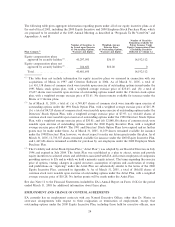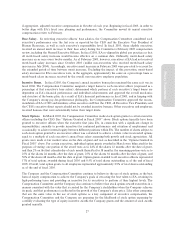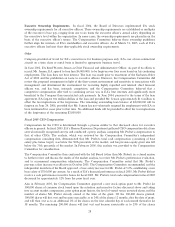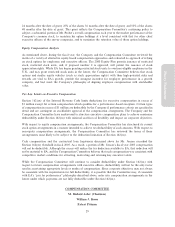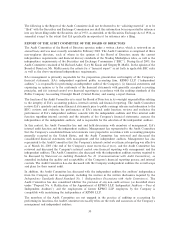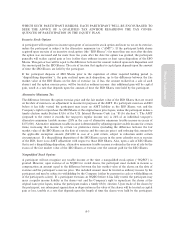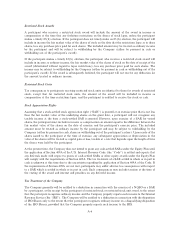Electronic Arts 2005 Annual Report Download - page 40
Download and view the complete annual report
Please find page 40 of the 2005 Electronic Arts annual report below. You can navigate through the pages in the report by either clicking on the pages listed below, or by using the keyword search tool below to find specific information within the annual report.Executive Ownership Requirements. In Ñscal 2004, the Board of Directors implemented EA stock
ownership requirements for all executive oÇcers. These ownership requirements are established as multiples
of the executive's base pay, ranging from one to six times the executive oÇcer's annual salary depending on
the executive's level within the organization. In some cases, the ownership requirements are phased in on the
basis of the executive oÇcer's tenure. The Compensation Committee believes these ownership guidelines
further align the interests of EA's stockholders and executive oÇcers. As of March 31, 2005, each of EA's
executive oÇcers had met their then-applicable stock ownership requirements.
Other
Company-provided air travel for EA's executives is for business purposes only. EA's use of non-commercial
aircraft on a time share or rental basis is limited to appropriate business travel.
In June 2002, EA hired Warren Jenson as Chief Financial and Administrative OÇcer. As part of its eÅorts to
recruit Mr. Jenson, EA agreed to loan him $4,000,000, to be forgiven over four years based on his continuing
employment. The loan does not bear interest. The loan was made prior to enactment of the Sarbanes-Oxley
Act of 2002 and the prohibition on loans to executive oÇcers. However, the Compensation Committee did
review this proposed arrangement in light of the then-current environment and sensitivity to transactions with
management and determined the environment for recruiting highly regarded and talented chief Ñnancial
oÇcers was, and has been, intensely competitive, and the Compensation Committee believed that a
competitive compensation oÅer tied to continuing service was in EA's best interests and signiÑcantly more
beneÑcial to the Company than unrestricted cash payments. In June 2004, pursuant to the terms of the loan
agreement, EA forgave two million dollars of the loan and provided Mr. Jenson approximately $1.6 million to
oÅset the tax implications of the forgiveness. The remaining outstanding loan balance of $2,000,000 will be
forgiven on June 24, 2006, provided that Mr. Jenson has not voluntarily resigned his employment with EA or
been terminated for cause prior to that time. No additional funds will be provided to oÅset the tax implications
of the forgiveness of the remaining $2,000,000.
Fiscal 2005 CEO Compensation
Compensation for the CEO is determined through a process similar to that discussed above for executive
oÇcers in general. In Ñscal 2005, EA's Human Resources Department gathered CEO compensation data from
several nationally recognized surveys and conducted a proxy analysis comparing Mr. Probst's compensation to
that of other CEOs. The analysis, which was reviewed by the Compensation Committee's independent
compensation consulting Ñrm, demonstrated that Mr. Probst's total cash compensation (consisting of base
salary plus bonus target) was below the 50th percentile of the market, and his previous equity grant also fell
below the 75th percentile of the market. In February 2005, this analysis was provided to the Compensation
Committee for consideration.
The Compensation Committee then conferred with the full Board (other than Mr. Probst) in a closed session
to further review and discuss the results of the market analysis, to review Mr. Probst's performance evaluation,
and to recommend compensation adjustments. The Compensation Committee noted that Mr. Probst's
previous salary increase was eÅective in October 2003. The Compensation Committee recommended, and the
independent members of the Board approved, a base salary increase for Mr. Probst of 5.2%, establishing a new
base salary of $710,000 per annum. As a result of EA's Ñnancial performance in Ñscal 2005, Mr. Probst did not
receive a cash performance incentive bonus for Ñscal 2005. Mr. Probst's total cash compensation in Ñscal 2005
decreased by approximately 52% from the prior Ñscal year.
Also in February 2005, the Compensation Committee approved a new stock option grant to Mr. Probst for
300,000 shares of common stock based upon the retention and incentive factors discussed above and taking
into account market comparisons, prior option grant history, the level of vested versus unvested shares and the
number of shares Mr. Probst already owned at the time of the grant. Of the 300,000 shares granted,
100,000 shares will Ñrst vest and become exercisable as to 24% of the shares 12 months after the date of grant,
and will then vest as to an additional 2% of the shares on the Ñrst calendar day of each month thereafter for
38 months. The remaining 200,000 shares will Ñrst vest and become exercisable as to 25% of the shares
28








